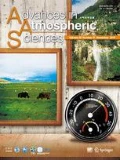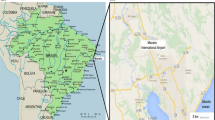Abstract
In this paper, a heavy sea fog episode that occurred over the Yellow Sea on 9 March 2005 is investigated. The sea fog patch, with a spatial scale of several hundred kilometers at its mature stage, reduced visibility along the Shandong Peninsula coast to 100 m or much less at some sites. Satellite images, surface observations and soundings at islands and coasts, and analyses from the Japan Meteorology Agency (JMA) are used to describe and analyze this event. The analysis indicates that this sea fog can be categorized as advection cooling fog. The main features of this sea fog including fog area and its movement are reasonably reproduced by the Fifth-generation Pennsylvania State University/National Center for Atmospheric Research Mesoscale Model (MM5). Model results suggest that the formation and evolution of this event can be outlined as: (1) southerly warm/moist advection of low-level air resulted in a strong sea-surface-based inversion with a thickness of about 600 m; (2) when the inversion moved from the warmer East Sea to the colder Yellow Sea, a thermal internal boundary layer (TIBL) gradually formed at the base of the inversion while the sea fog grew in response to cooling and moistening by turbulence mixing; (3) the sea fog developed as the TIBL moved northward and (4) strong northerly cold and dry wind destroyed the TIBL and dissipated the sea fog. The principal findings of this study are that sea fog forms in response to relatively persistent southerly warm/moist wind and a cold sea surface, and that turbulence mixing by wind shear is the primary mechanism for the cooling and moistening the marine layer. In addition, the study of sensitivity experiments indicates that deterministic numerical modeling offers a promising approach to the prediction of sea fog over the Yellow Sea but it may be more efficient to consider ensemble numerical modeling because of the extreme sensitivity to model input.
Similar content being viewed by others
References
Anthes, R. A., E. Y. Hsie, and Y. H. Kuo, 1987: Description of the Penn State/NCAR Mesoscale Model version 4 (MM4). NCAR Tech. Note. NCAR/TN-282+STR., 66pp.
Ballard, S., B. Golding, and R. Smith, 1991: Mesoscale model experimental forecasts of the haar of northeast Scotland. Mon. Wea. Rev., 119, 2107–2123.
Benjamin, S. G., and N. L. Seaman, 1985: A simple scheme for objective analysis in curved flow. Mon. Wea. Rev., 113, 1184–1198.
Benjamin, S. B., and P. A. Miller, 1990: An alternative sea-level pressure reduction and a statistical comparison of geostrophic winds estimated with observed surface winds. Mon. Wea. Rev., 118, 2099–2116.
Bergot, T., and D. Guedalia, 1994: Numerical forecasting of radiation fog. Part I: Numerical model and sensitivity tests. Mon. Wea. Rev., 122, 1218–1230.
Blackadar, A. K., 1979: High resolution models of the planetary boundary layer. Advances in Environmental Science and Engineering, 1, 50–85.
Burk, S. D., and W. T. Thompson, 1989: A vertically nested regional numerical prediction model with second-order closure physics. Mon. Wea. Rev., 117, 2305–2324.
Cho, Y. K., M. O. Kim, and B. C. Kim, 2000: Sea fog around the Korean Peninsula. J. Appl. Meteor., 39, 2473–2479.
Diao Xuexian, 1996: Main features of sea fog on Qingdao and its neighboring sea areas. Marine Science Bulletin, 15, 87–91. (in Chinese)
Dudhia, J., 1989: A nonhydrostatic version of the Penn State-NCAR mesoscale model. Mon. Wea. Rev., 121, 1493–1513.
Dudhia, J., 1996: A multi-layer soil temperature model for MM5. Sixth Annual PSU/NCAR Mesoscale Model Users’ Workshop, Boulder CO, July 1996, 49–51.
Fan Qi, Wang Anyu, Fan Shaojia, Wu Dui, Deng Xuejiao, and Liu Yingwei, 2003: Numerical prediction experiment of an advection fog in Nanling Mountain area. Acta Meteorologica Sinica, 17, 337–349.
Findlater, J., W. Roach, and B. McHugh, 1989: The haar of north-east Scotland. Quart. J. Roy. Meteor. Soc., 115, 581–608.
Fu Gang, Wang Jingqian, Zhang Meigen, Guo Jingtian, Guo Mingke and Guo Kecai, 2004: An observational and numerical study of a sea fog event over the Yellow Sea on 11 April 2004. Journal of Ocean University of China, 34, 720–726. (in Chinese)
Fu Gang, Zhang Tao, and Zhou Faxiu, 2002: Three-dimensional numerical simulation of real sea fog event over the Yellow Sea. Journal of Ocean University of Qingdao, 32, 859–867. (in Chinese)
Garratt, J. R., 1987: The stably stratified internal boundary layer for steady and diurnally varying offshore flow. Bound.-Layer Meteor., 38, 369–394.
Grell, G. A., J. Dudhia, and D. R. Stauffer, 1994: Description of the Fifth-generation Penn State/NCAR Mesoscale Model (MM5). NCAR Tech. Note. NCAR/TN-398+STR., 122pp.
Hong, S. Y., and H. L. Pan, 1996: Nonlocal boundary layer vertical diffusion in a medium-range forecast model. Mon. Wea. Rev., 124, 2232–2339.
Hu Jifu, Guo Kecai, and Yan Linong, 1996: Discriminate prediction of marine fog occurrence using a model output statistics scheme. Journal of Ocean University of Qingdao, 26, 439–445. (in Chinese)
Hu Ruijin, and Zhou Faxiu, 1997: A numerical study of the effects of air-sea conditions on the process of sea fog. Journal of Ocean University of Qingdao, 27, 282–290. (in Chinese)
Janjic, Z. I., 1994: The step-mountain eta coordinate model: Further developments of the convection, viscous sublayer, and turbulence closure schemes. Mon. Wea. Rev., 122, 927–945.
Jing Chuancai, 1980: A preliminary analysis of sea fog off the Qingdao coast. Meteorological Monthly, 65, 6–8. (in Chinese)
Klemp, J. B., and D. R. Durran, 1983: An upper boundary condition permitting internal gravity wave radiation in numerical mesoscale models. Mon. Wea. Rev., 111, 430–444.
Koračin, D., J. Lewis, W. T. Thompson, C. E. Dorman, and J. A. Businger, 2001: Transition of stratus into fog along the California coast: Observation and modeling. J. Atmos. Sci., 58, 1714–1731.
Kunkel, B., 1984: Parameterization of droplet terminal velocity and extinction coefficient in fog models. J. Appl. Meteor., 23, 34–41.
Leipper, D., 1994: Fog on the U. S. West Coast: A review. Bull. Amer. Meteor. Soc., 75, 229–240.
Lewis, J. M., D. Koračin, and K. T. Redmond, 2004: Sea fog research in the United Kingdom and United States. Bull. Amer. Meteor. Soc., 85, 395–408.
Lewis, J. M., D. Koračin, R. Rabin, and J. Businger, 2003: Sea fog off the California coast. J. Geophys. Res., 108(D15), 4457, doi:10.1029/2003JD002833.
Mlawer, E. J., S. J. Taubman, P. D. Brown, M. J. Iacono, and S. A. Clough, 1997: Radiative Transfer for Inhomogeneous Atmospheres: RRTM, a validated correlated-k model for the longwave. J. Geophys. Res., 102, 16663–16682.
Pagowski, M., I. Gultepe, and P. King, 2004: Analysis and modeling of an extremely dense fog event in southern Ontario. J. Appl. Meteor., 43, 3–16.
Pilié, R., E. Mack, C. Rogers, U. Katz, and W. Kocmond, 1979: The formation of marine fog and the development of fog-stratus systems along the California coast. J. Appl. Meteor., 18, 1275–1286.
Reisner, J., R. J. Rasmussen, and R. T. Bruintjes, 1998: Explicit forecasting of supercooled liquid water in winter storms using the MM5 mesoscale model. Quart. J. Roy. Meteor. Soc., 124, 1071–1107.
Stauffer, D. R., R. C. Munz, and N. L. Seaman, 1999: In-cloud turbulence and explicit microphysics in the MM5. Proc. Ninth PSU/NCAR Mesoscale MODEL User’s Workshop, Boulder, CO, NCAR, 177–180.
Stoelinga, M. T., and T. W. Thomas, 1998: Nonhydrostatic, mesobeta-scale model simulations of cloud ceiling and visibility for an East Coast winter precipitation event. J. Appl. Meteor., 38, 385–403.
Taylor, G., I., 1917: The formation of fog and mist. Quart. J. Roy. Meteor. Soc., 43, 241–268.
Wang Binhua, 1983: Sea Fog. China Ocean Press, 352pp. (in Chinese)
Wang Houguang, and Qu Weizhen, 1997: Sea fog prediction for Qingdao area. Marine Forecasts, 14, 52–57. (in Chinese)
Zhang, D. L., and R. A. Anthes, 1982: A high-resolution model of the planetary layer-sensitivity test and comparisons with SESAME-79 data. J. Appl. Meteor., 21, 1594–1609.
Zhang Hongyan, Zhou Faxiu, and Zhang Xiaohui, 2005: Interannual change of sea fog over the Yellow Sea in spring. Oceanologia et Limnologia Sinica, 36, 36–42. (in Chinese)
Zhao Yongping, Chen Yongli, and Wang Pigao, 1997: Analysis of atmospheric and oceanic conditions for marine fog formation over the Yellow Sea and east China Seas. Studia Marina Sinica, 38, 69–79. (in Chinese)
Zhou Faxiu, Wang Xin, and Bao Xianwen, 2004: Climatic characteristics of sea fog formation of the Huanghai Sea in spring. Acta Oceanologia Sinica, 26, 28–37. (in Chinese)
Author information
Authors and Affiliations
Rights and permissions
About this article
Cite this article
Gao, S., Lin, H., Shen, B. et al. A heavy sea fog event over the Yellow Sea in March 2005: Analysis and numerical modeling. Adv. Atmos. Sci. 24, 65–81 (2007). https://doi.org/10.1007/s00376-007-0065-2
Received:
Revised:
Issue Date:
DOI: https://doi.org/10.1007/s00376-007-0065-2



